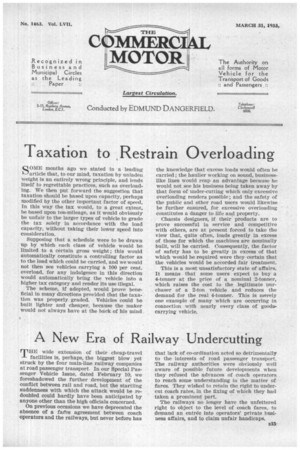Taxation to ,Restrain Overloading
Page 29

If you've noticed an error in this article please click here to report it so we can fix it.
SONIE months ago we stated in a leading ---/article that, to our mind, taxation by unladen weight is an entirely wrong principle, and lends itself to regrettable practices, such as overloading. We then put forward the suggestion that taxation should be based upon capacity, perhaps modified by the other important factor of speed. In this way the tax would, to a great extent, be based upon ton-mileage, as it would obviously be unfair to the larger types of vehicle to grade the tax solely in accordance with the load capacity, without taking their lower speed into consideration.
Supposing that a schedule were to be drawn up by which each class of vehicle would be limited to a certain gross weight ; this would automatically constitute a controlling factor as to the load which could be carried, and we would not then see vehicles carrying a 100 per cent. overload, for any indulgence in this direction would automatically bring the vehicle into a higher tax category and render its use illegal.
The scheme, if adopted, would Prove beneficial in many directions provided that the taxation was properly graded. Vehicles could be built lighter and cheaper, because the maker would not always have at the back of his mind_ the knowledge that excess loads would often be carried ; the haulier working on sound, businesslike lines would reap an advantage because he would not see his business being taken away by that form of under-cutting which only excessive overloading renders possible ; and the safety of the public and other road users would likewise be further ensured, for excessive overloading constitutes a danger to life and property.
Chassis designers, if their products are to prove successful in service and competitive with others, are at present forced to take the view that, quite often, loads greatly in excess of those for which the machines are nominally built, will be carried. Consequently, the factor of safety has to be greatly in excess of that which would be required were they certain that the vehicles would be accorded fair treatment.
This is a most unsatisfactory state of affairs. It means that some users expect to buy a 4-tonner at the price of a nominal 2-tonner, which raises the cost to the legitimate purchaser of a 2-ton vehicle and reduces the demand for the real 4-tonner. This is merely one example of many which are occurring in connection with nearly every class of goodscarrying vehicle.




























































































